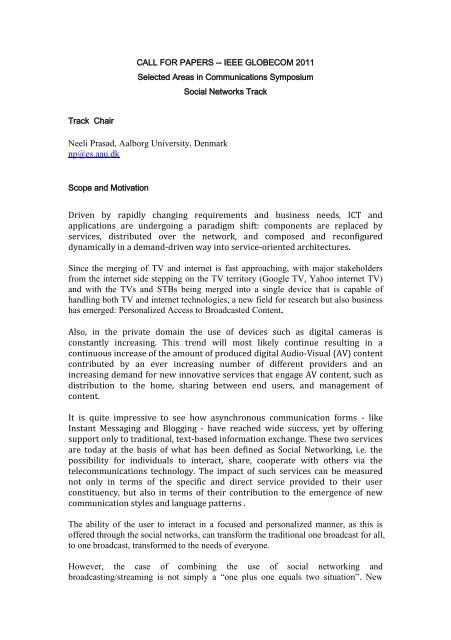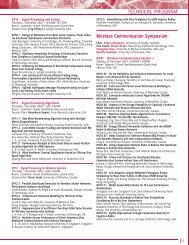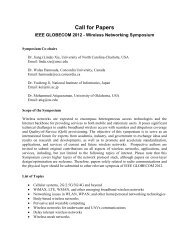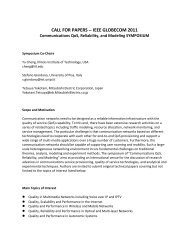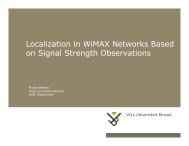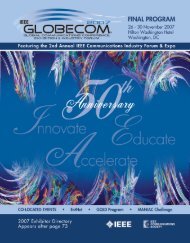Neeli Prasad, Aalborg University, Denmark np@es.aau.dk Driven by ...
Neeli Prasad, Aalborg University, Denmark np@es.aau.dk Driven by ...
Neeli Prasad, Aalborg University, Denmark np@es.aau.dk Driven by ...
Create successful ePaper yourself
Turn your PDF publications into a flip-book with our unique Google optimized e-Paper software.
CALL FOR PAPERS -- IEEE GLOBECOM 2011<br />
Selected Areas in Communications Symposium<br />
Social Networks Track<br />
Track Chair<br />
<strong>Neeli</strong> <strong>Prasad</strong>, <strong>Aalborg</strong> <strong>University</strong>, <strong>Denmark</strong><br />
<strong>np@es</strong>.<strong>aau</strong>.<strong>dk</strong><br />
Scope and Motivation<br />
<strong>Driven</strong> <strong>by</strong> rapidly changing requirements and business needs, ICT and<br />
applications are undergoing a paradigm shift: components are replaced <strong>by</strong><br />
services, distributed over the network, and composed and reconfigured<br />
dynamically in a demand-driven way into service-oriented architectures.<br />
Since the merging of TV and internet is fast approaching, with major stakeholders<br />
from the internet side stepping on the TV territory (Google TV, Yahoo internet TV)<br />
and with the TVs and STBs being merged into a single device that is capable of<br />
handling both TV and internet technologies, a new field for research but also business<br />
has emerged: Personalized Access to Broadcasted Content.<br />
Also, in the private domain the use of devices such as digital cameras is<br />
constantly increasing. This trend will most likely continue resulting in a<br />
continuous increase of the amount of produced digital Audio-Visual (AV) content<br />
contributed <strong>by</strong> an ever increasing number of different providers and an<br />
increasing demand for new innovative services that engage AV content, such as<br />
distribution to the home, sharing between end users, and management of<br />
content.<br />
It is quite impressive to see how asynchronous communication forms - like<br />
Instant Messaging and Blogging - have reached wide success, yet <strong>by</strong> offering<br />
support only to traditional, text-based information exchange. These two services<br />
are today at the basis of what has been defined as Social Networking, i.e. the<br />
possibility for individuals to interact, share, cooperate with others via the<br />
telecommunications technology. The impact of such services can be measured<br />
not only in terms of the specific and direct service provided to their user<br />
constituency, but also in terms of their contribution to the emergence of new<br />
communication styles and language patterns .<br />
The ability of the user to interact in a focused and personalized manner, as this is<br />
offered through the social networks, can transform the traditional one broadcast for all,<br />
to one broadcast, transformed to the needs of everyone.<br />
However, the case of combining the use of social networking and<br />
broadcasting/streaming is not simply a “one plus one equals two situation”. New
issues are raised related to actions of users/viewers and how this is influenced and<br />
influences viewing experience, how it affects the QoE and ways it can improve it,<br />
techniques for fusing user generated content in a non intrusive and annoying or<br />
destructing way with the broadcasted content and also how can user generated content<br />
modify the transmission.<br />
Furthermore, the use of social networking in combination with P2P techniques in<br />
order to improve the efficiency of the media distribution chain is an important issue,<br />
since the use of user profiles and preferences can be harnessed both to setup a more<br />
robust media distribution framework, but also to enhance the user experience due to<br />
more interesting and focused information available.<br />
Finally, the issue of personalized advertisements and personalized announcements (i.e.<br />
<strong>by</strong> public organizations such as announcement for quitting smoking) along with<br />
privacy concerns is an important topic.<br />
Main Topics of Interest, but not limited to<br />
<br />
<br />
<br />
<br />
<br />
<br />
<br />
<br />
<br />
<br />
<br />
<br />
<br />
<br />
Social network behaviors, dynamics, modeling, and analysis<br />
Representation, measurement, modeling of relationship or user behaviors<br />
Social network topology, complex network theory, random graph, and relationship to<br />
statistical mechanics or biology<br />
Web connections and cloud services<br />
Belief and message propagation, search technology over Internet<br />
Trusted networking, security, privacy, and digital right management over social<br />
networking<br />
Cognitive modeling, machine learning, game theory, computational intelligence,<br />
applied in social networks<br />
Applications and services to Internet, multimedia networks, e-commerce, and mobilecommerce<br />
Architecture and Distributed framework<br />
Personalization<br />
Social Interaction and Quality of Life (QoL) & Quality of Experience (QoE)<br />
Tools for designing and deploying social networks<br />
Application programming interfaces (APIs) for social networks<br />
Business Model and Open Innovation<br />
Technical Program Committee


